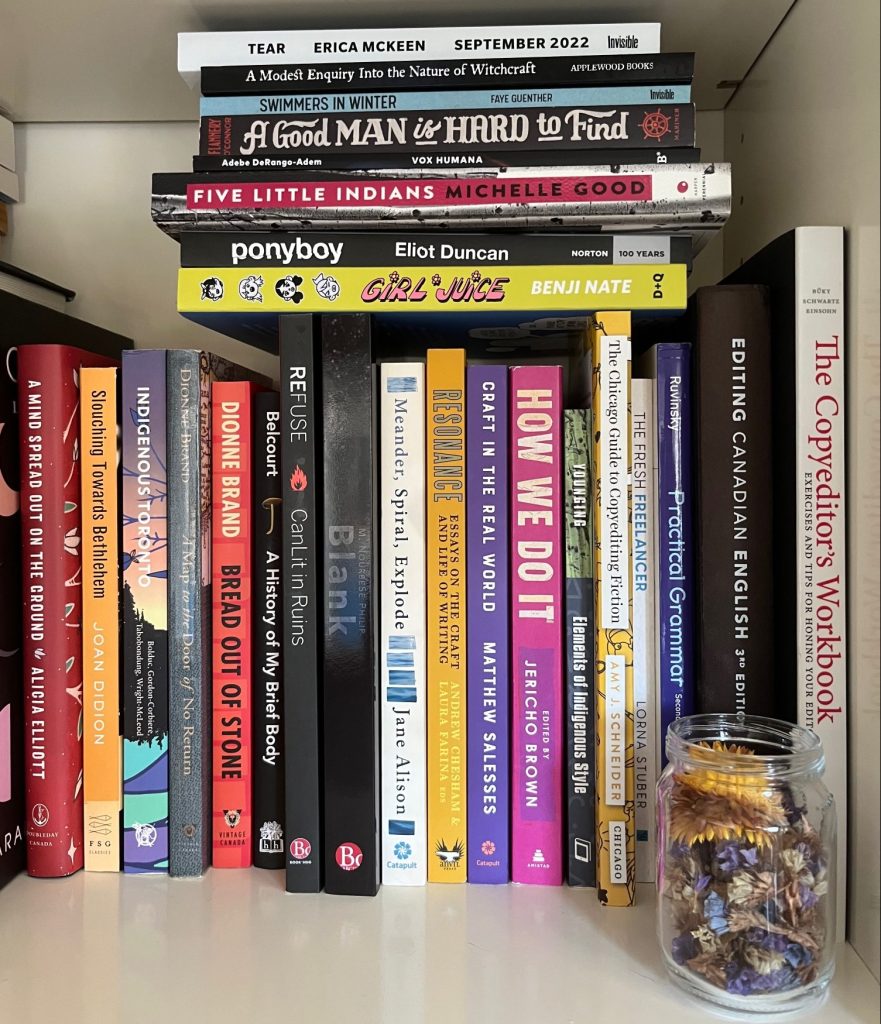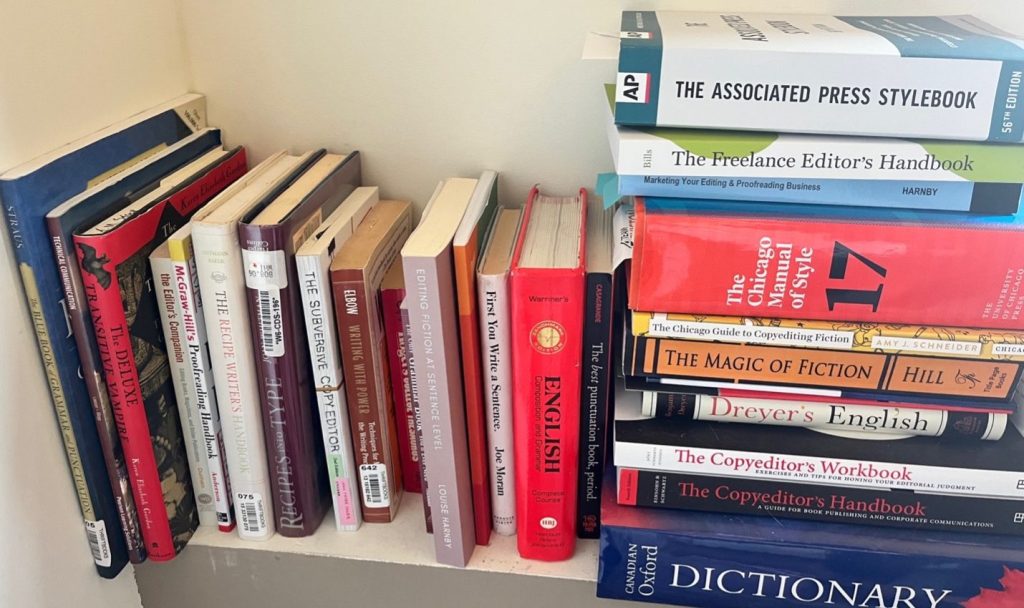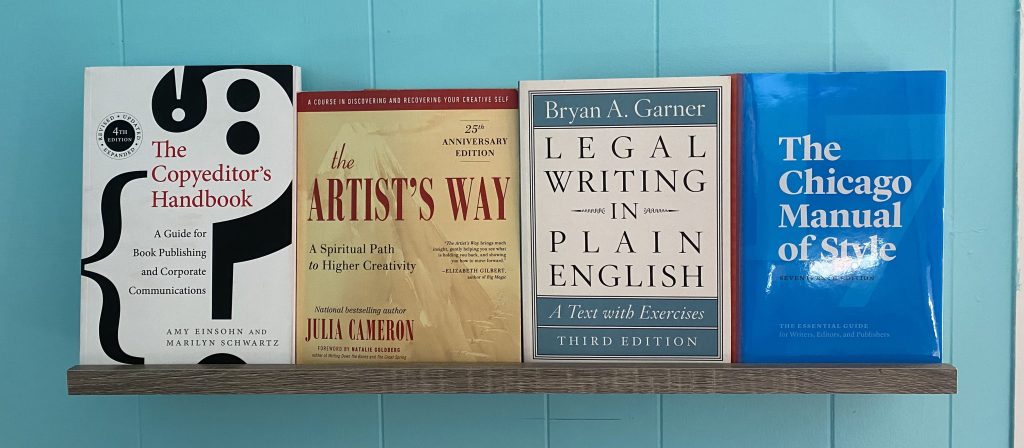In this column, members of the editing community share what’s on their bookshelves and mention some titles that are noteworthy to them. Books by Ursula K. Le Guin, Cheryl Stephens, and Sally Foster Wallace were highlighted in our previous instalment. In this, our fourth “Bookshelf” post, editors in Brampton, Vancouver, and Toronto share their favourites. If you’d like to show us your bookshelf, let us know!
Erin Della Mattia (she/her) is a freelance editor. Her bookshelf is in Brampton, Ontario.

My editing and writing books take up a small section of the non-fiction shelf of the bookcase in my bedroom. (Also pictured is a stack of some of the books I’ve read lately or intend to read soon.)
Perhaps because I’m still at the beginning of my editing career, I don’t have that many editing books yet. I have the standard ones that most of us acquired for editing courses, like Editing Canadian English, 3rd edition, and Maxine Ruvinsky’s Practical Grammar: A Canadian Writer’s Resource. I still whip them out when something in a manuscript stumps me.
Two books I used a lot this year were Gregory Younging’s Elements of Indigenous Style and Amy J. Schneider’s Chicago Guide to Copyediting Fiction, which I usually keep next to me when copy editing. While the online version of CMOS is basically indispensable, I like using Schneider’s book as a reference because of the writing style: it sounds like an actual person is speaking to you.
I do a lot of developmental editing, and I’ve found that books on writing craft and the publishing industry are invaluable for deepening my critical awareness of what it means to do this type of work (i.e., writing, editing, and publishing). Bla_k: Essays and Interviews by M. NourbeSe Philip and Refuse: CanLit in Ruins both shape my view of writing and publishing in Canada and what I believe my responsibility is/could be/should be within the industry. Craft in the Real World by Matthew Salesses is another excellent book that looks at how writing craft is informed by cultural values and how we can make space for diverse writing traditions. His focus is on writing programs and workshops, but it’s been useful for thinking through how to navigate the editor-author power dynamic.
Susan Kokura is a non-fiction copy editor with a background in technical writing and industrial design. Her bookshelf is in Vancouver.

The resource I pick up most often amid this bookshelf selection (okay, maybe more of a nook than a shelf) would have to be Dreyer’s English: An Utterly Correct Guide to Clarity and Style. Dreyer’s dry wit helps me digest the information easily. I find myself chuckling often while I’m learning. He’s even helped me to relax my hardline approach to following every rule to the letter. I now leave copy that flows well and sounds natural as is, even if it contains a split infinitive (as per my all-time favourite Star Trek example, “To boldly go where no man has gone before”). In other words, don’t mess with it just to follow a rule, potentially making it sound awkward.
I am currently a non-fiction editor but would love to dive into the fiction pool at some point, so I had to jump on Amy J. Schneider’s Chicago Guide to Copyediting Fiction as soon as it came out. In writing this article, I am reminded that I need to crack open these books more often.
Andrea Benjamin is a freelance legal editor at www.abedits.ca. Her bookshelf is in Toronto.

I first read Brian Garner’s Legal Writing in Plain English 15 years ago in law school. It is now in its third edition and is every bit as salient. Throughout the book, Garner stresses the importance of writing in a way that is accessible to the reader. To that end, he provides many useful tools and techniques, as well as practical exercises at the end of each chapter. While the book is targeted toward lawyers (who are not exactly known for their economy of words!), it can also help writers and editors of all stripes who want to learn to communicate clearly and effectively.
Another title with a permanent position on my editing bookshelf is Julia Cameron’s The Artist’s Way: A Spiritual Path to Higher Creativity. This book has garnered a cult following, and for good reason: it presents potent tools that are as useful in creative endeavours as they are in everyday life.
Cameron instructs the reader to wake up 30 minutes early each morning and fill three pages with longhand, stream-of-consciousness writing. The content of the pages does not matter—just the act of writing them can yield massive benefits. In my experience, writing my morning pages helps me clear my mind by emptying out all my thoughts onto paper. After I’m done, I can more easily focus on whatever task lies ahead.
Editing is as much an art as it is a science. As such, it requires the editor to think both logically and creatively. Rules are followed and rules are bent. The Artist’s Way has enabled me to access the well of creative energy that is needed to do the work of an editor.
This article was copy edited by Vilma Indra Vītols, a freelance editor and opera singer living in Toronto. She is a member of the Plain Language Association International (PLAIN) and sings with the Canadian Opera Company chorus.
